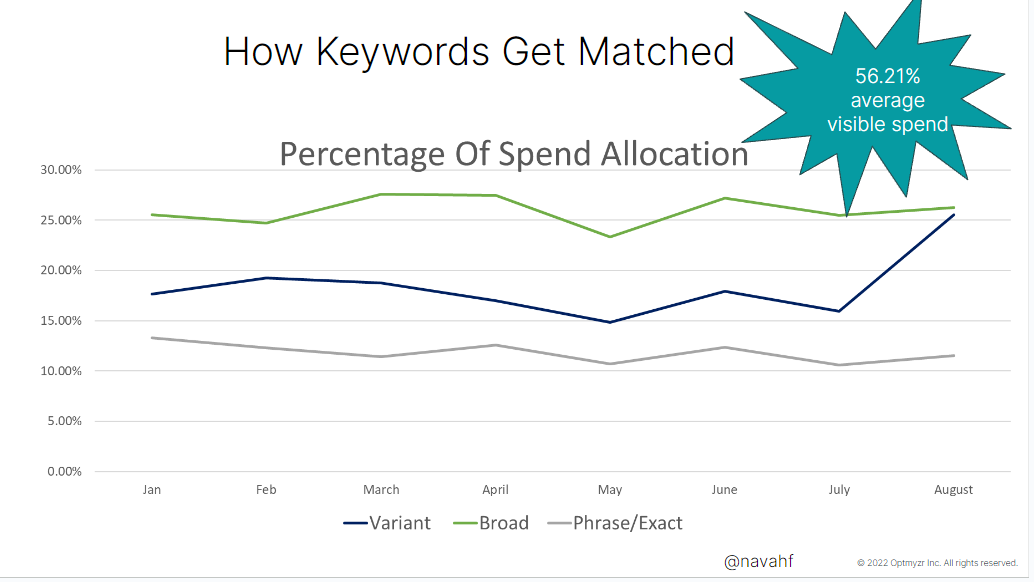Part of what makes digital advertising challenging is that UIs change just as constantly as algorithms.
It can be tough to stay on top of all the changes and tasks required for peak account performance.
While these may be known to some, they represent the most common “hidden levers” I see in account audits.
Hidden Lever #1: Competitor Audiences
When someone seeks a product, what triggers their search?
Which brands do they gravitate towards for research, exploration, or confirmation?
How do these interactions shape their eventual purchasing decision?
An often-overlooked gem in the consumer intent space is “competitor audience segment” targeting.
Found under the audience manager, this tool enables advertisers to include websites frequently visited by their target audience.
This option is integrated into Performance Max (PMAX) and display campaigns but is not yet available for standalone search targeting, which is a tad disappointing.
You can list multiple websites or customer segments. Google then identifies users who’ve visited those sites (or similar ones) as prime targets for your ads.
Pair this with a placement exclusion list to ensure you’re not displaying ads on undesired pages. This could be your own site or potentially a direct competitor’s content.
You’re given the flexibility to either exclude or specifically target a competitor.
The brilliance lies in harnessing your competitor’s marketing efforts and budget, redirecting the interest they’ve cultivated, and potentially turning it into profit for yourself.
In essence, the “competitor audience segment” allows you to strategically position your campaigns, piggybacking off your competitor’s hard work and potentially capturing a share of their audience.
Hidden Lever #2: Using Search Term Filters
Over the years, the utility of the search terms report has waned.
Our visibility into search terms has diminished, making it cumbersome to introduce negative keywords or add new keyword targets, especially for extensive queries.
 Image from author, September 2023
Image from author, September 2023Comparing targeted keywords with the actual search terms ensures you’re bidding on the most productive version of the keyword.
As account structures evolve, with a heightened focus on audiences rather than just keywords, the search terms report becomes instrumental in discerning which keywords to prioritize, rather than merely relying on the suggestions from the keyword planner.
To harness this:
- Navigate to attributes within your interface.
- Filter by attribute and the specific search term in question.
- Activate the column that displays the keyword that triggered the search term.
- It’s also advisable to incorporate “match type.” This offers insight into the frequency of close variants being activated by your campaigns.
Depending on your campaign type and account structure, a surge in close variants might signal a lack of negative keywords safeguarding your ad groups.
This diagnostic is pivotal to ensure the presence of negative keywords at respective levels, and it seamlessly transitions into our next overlooked feature, which we’ll delve into next.
Hidden Lever #3: Negatives At Every Structural Level
Most seasoned PPC practitioners inherently understand the importance of negative keywords. However, I’ve recently observed a noticeable number of campaigns that either lack negative keywords entirely or employ them sparingly.
Why is the meticulous inclusion of negative keywords pivotal?
- Close variants: Negative keywords act as a bulwark against these close variants, ensuring that your ads are being triggered by the most relevant search terms.
- Budget optimization: Negative keywords play a crucial role in budget allocation. The vast majority of accounts need to steer the budget from one campaign or ad group to another.
In the absence of well-defined negative keywords, there’s a genuine risk of overspending on less impactful ideas while neglecting the more promising ones.
In summary, while negative keywords might not be a “new” concept for many, their consistent and thoughtful application can make all the difference between a well-optimized campaign and one that misdirects valuable resources.
So, regardless of how basic or advanced you deem this feature, it’s worth revisiting and refining your negatives regularly.
Hidden Lever #4: Audience And Placement Targets & Exclusions
It’s disheartening to audit campaigns and find glaring omissions of audience targets/exclusions or specific placement targets/exclusions.
Such omissions deprive campaigns of possibly their most potent tool to ensure budget precision and meaningful engagement with the ideal customer.
Here’s the breakdown.
Audience Targets
If you’re sidelining the inclusion of audience targets (whether “Target and Observe” or even “Observe” settings), you’re opting into a bigger traffic pool.
The reality is that not everyone is your potential customer.
Interface intricacies sometimes render these settings less evident, which might explain their occasional neglect. However, comprehending their placement is paramount.
Exclusions For Visual Content
Toggle between topics, placements, and content keywords to ensure needed exclusion rather than just defaults.
An additional tool, the “Where and When Ad Served” report (still in open beta for some users), offers insights on which placements to either target or exclude.
For PMAX Campaigns
Audience signals are paramount in the nascent stages of a PMAX campaign but tend to diminish in impact over time.
To tweak these, head to the Asset Group section and click the pencil icon on the right. Once inside, you’ll be equipped to edit your audience signals.
Though the layout is not as intuitive as other campaign types, familiarizing yourself is critical for optimizing Performance Max campaigns.
Remember, blending your data with Google’s signals based on various audience settings can amplify your campaign’s impact.
Audience Library & Manager
This is your gateway to crafting custom audiences. With this, you can integrate interest targets and even upload conversions, paving the way to generate audiences from past converters.
In a nutshell, while these functionalities might not be entirely “hidden,” their full potential is often overlooked.
Delving deep and employing them judiciously can be the difference between a campaign that simply runs and one that truly resonates.
Hidden Lever #5: Ad Group Versus Campaign-Level Settings Across Platforms
Navigating ad settings can be a challenging affair, especially when you’re toggling between various ad networks. Each network has its own hierarchy of campaign and ad group settings, making it easy to miss critical settings.
Let’s delve into this overlooked feature by breaking down the nuances across popular platforms.
Google Ads: Campaign-Centric
Google prioritizes campaign-level settings for schedules, budgets, location targeting, and negatives.
You’ll likely have to set up multiple campaigns with distinct budgets for each objective.
Fewer ad groups per campaign are advisable, usually between five to seven, depending on the volume you’re targeting.
Microsoft Ads: A Blend Of Both
While resembling Google in requiring most settings at the campaign level, Microsoft Ads offers more flexibility at the ad group level.
You can override locations and schedules, and make specific placement choices. This flexibility allows for a more tailored advertising strategy.
Facebook (Meta) Ads: Flexible Objectives
Facebook doesn’t constrain you to campaign or ad group settings. You can opt for either Campaign Budget Optimizer, behaving much like Google Ads, or allocate budget per ad and target.
The approach you choose significantly impacts your spending.
The flexibility means you can support general objectives or perform extensive creative testing but be prepared for varied budgetary implications.
LinkedIn Ads: Ad Set-Focused
LinkedIn prioritizes ad set settings, letting you make most choices at this level. Campaigns generally dictate asset association.
If you’re advertising on LinkedIn, expect to need a robust ad group structure that caters to each major part of your business.
Amazon Ads: Product-Based Budgeting
Amazon’s approach centers around the products you want to promote rather than campaign or ad group settings.
While you’re limited in location targeting, Amazon excels in providing a robust first-party audience network. Your budgeting is driven by product selection.
Regardless of the ad network you’re using, it’s crucial to understand these underlying structures for more effective planning and budget allocation.
Understanding these “hidden” settings can make a significant difference in the efficiency and effectiveness of your advertising campaigns.
Hidden Lever #6: Using Segments For Precision Analysis
Segments allow you to dive into the data of your campaigns. You can dig into:
- Network.
- Conversion Data.
- Time.
- Location.
- Device.
These segments will help answer whether there are false positives/negatives in the averages.
For example, if you see a seemingly low click-through rate (CTR) or cost per click (CPC) and have Search Partners with Display Expansion turned on, you might be having your numbers skewed.
By using segments, you’ll get a more accurate view of what’s happening in your account and be able to make meaningful optimizations.
Hidden Lever #7: Conversion Tracking
Understanding and optimizing conversion settings can ensure that the data you rely on is both accurate and actionable.
The Importance Of Trustworthy Data
In a modeled tracking landscape, placing confidence in the data you acquire is critical. A typical oversight is the default 30-second window for phone call conversions, which is impractical for most businesses.
A more realistic threshold would be two to three minutes – or even longer for certain sectors.
However, if you don’t adjust that setting, you’re asking for bad data to flow into both your bidding and reporting.
Navigating Primary And Secondary Conversion Settings
Google automatically categorizes conversion actions as primary. While some can’t be modified, others should be adjusted according to business needs.
Primary conversions influence the algorithm and appear in reports.
Secondary conversions are tracked in ‘all conversions’ but don’t impact the algorithm or main reporting metrics.
Configuring Primary And Secondary Settings
Contrary to what one might assume, these settings are adjusted at the “goal level,” and not the “conversion action level.”
Once you’ve determined your desired conversion actions (whether imported from GA4 or using native actions), the process involves:
- Selecting Edit goal.
- Toggling between primary and secondary for each conversion action based on your preferences.
Properly adjusted conversion settings ensure that you’re measuring what truly matters to your business. By filtering by conversion action, you can discern the number and cost of the conversions you deem valuable.
Hidden Lever #8: Hidden Reports
Google Ads is as successful as it is because of the data it affords advertisers. Yet, in recent years, some of those reports have been depreciated or consolidated (making them tougher to action).
While not all of these reports are new or changed, they represent underutilized value:
Change History Report
The Change History report shows every modification made in an account, capturing who made each change. Additionally, it will share whether changes are manual or automatic suggestions from Google.
If there are a lot of auto-recommendations might prompt some advertisers to either switch them off or embrace them, contingent on the performance outcomes.
This report also reveals if the changes are consequential. For instance, seeing only IP exclusions without negative keyword additions or targeting tweaks could indicate the use of fraud-filtering tools but limited attention to campaign strategy.
It’s always best to consult with your team/vendor before jumping to any conclusions, as they may have a good reason for the limited human intervention.
Call Extension Report
This report delves into call details, such as listening to recorded calls (if activated) or assessing call durations. For those not leveraging call tracking, it’s an invaluable window to evaluate the efficacy of calls.
Located under ‘extensions reports,’ this report often gets a ‘wow’ reaction upon discovery and can be a way to diffuse account performance fears with data.
Insight Section & The Search Term Report
Google Ads underwent a redesign that separated core functions and insights. Consequently, the search term report now resides under “insights,” a move not mirrored by Microsoft Ads – yet.
The search term report is a cornerstone for understanding search behaviors and aligning campaign strategies.
Another notable report in this category is the “where and when ads showed, “a beacon for PMAX campaigns, offering respite from typical black-box reporting.
Hidden Lever #9: Shopping Attributes In Merchant Center
Google Merchant Center is often adding new attributes to customize feeds. Building in a once-per-month check-in can help keep you on top of your feed while helping to distinguish you from the competition.
Regularly updating and tailoring your feeds with enriched attributes can significantly boost the effectiveness of your campaign targeting and return on ad spend (ROAS).
Final Takeaways
Mastering every nook and cranny of ad networks may seem daunting. However, these platforms generally make choices based on user data.
Ad networks emphasize impactful changes over a bombardment of minor tweaks.
Notable shifts like the dynamic search ads transitioning towards Performance Max demonstrate the network’s intent to give users ample transition time.
If there’s an ad management aspect you cherish, keep it in regular use and voice your feedback. That might be enough to save the utility.
More resources:
- How Much Should PPC Management Cost?
- Generative AI Integration SERPs And PPC Advertisers
- The Biggest PPC Trends of 2023, According to 22 Experts
Featured Image: eamesBot/Shutterstock




